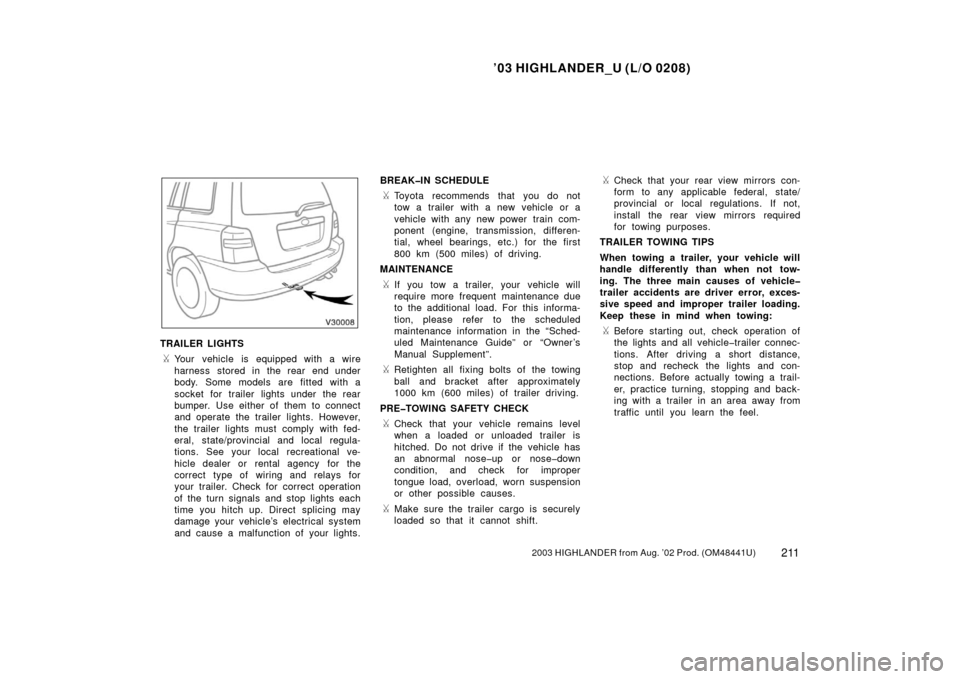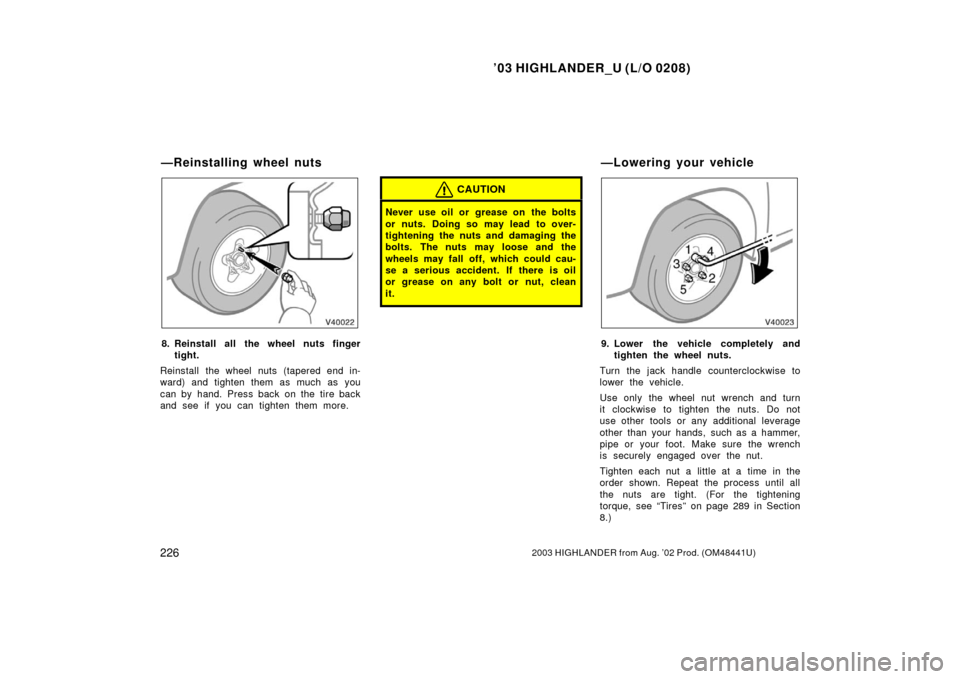Page 217 of 303

’03 HIGHLANDER_U (L/O 0208)
2112003 HIGHLANDER from Aug. ’02 Prod. (OM48441U)
TRAILER LIGHTS
�Your vehicle is equipped with a wire
harness stored in the rear end under
body. Some models are fitted with a
socket for trailer lights under the rear
bumper. Use either of them to connect
and operate the trailer lights. However,
the trailer lights must comply with fed-
eral, state/provincial and local regula-
tions. See your local recreational ve-
hicle dealer or rental agency for the
correct type of wiring and relays for
your trailer. Check for correct operation
of the turn signals and stop lights each
time you hitch up. Direct splicing may
damage your vehicle’s electrical system
and cause a malfunction of your lights. BREAK�IN SCHEDULE
�Toyota recommends that you do not
tow a trailer with a new vehicle or a
vehicle with any new power train com-
ponent (engine, transmission, differen-
tial, wheel bearings, etc.) for the first
800 km (500 miles) of driving.
MAINTENANCE
�If you tow a trailer, your vehicle will
require more frequent maintenance due
to the additional load. For this informa-
tion, please refer to the scheduled
maintenance information in the “Sched-
uled Maintenance Guide” or “Owner ’s
Manual Supplement”.
�Retighten all fixing bolts of the towing
ball and bracket after approximately
1000 km (600 miles) of trailer driving.
PRE�TOWING SAFETY CHECK
�Check that your vehicle remains level
when a loaded or unloaded trailer is
hitched. Do not drive if the vehicle has
an abnormal nose�up or nose�down
condition, and check for improper
tongue load, overload, worn suspension
or other possible causes.
�Make sure the trailer cargo is securely
loaded so that it cannot shift.
�Check that your rear view mirrors con-
form to any applicable federal, state/
provincial or local regulations. If not,
install the rear view mirrors required
for towing purposes.
TRAILER TOWING TIPS
When towing a trailer, your vehicle will
handle differently than when not tow-
ing. The three main causes of vehicle�
trailer accidents are driver error, exces-
sive speed and improper trailer loading.
Keep these in mind when towing:
�Before starting out, check operation of
the lights and all vehicle�trailer connec-
tions. After driving a short distance,
stop and recheck the lights and con-
nections. Before actually towing a trail-
er, practice turning, stopping and back-
ing with a trailer in an area away from
traffic until you learn the feel.
Page 230 of 303
’03 HIGHLANDER_U (L/O 0208)
2242003 HIGHLANDER from Aug. ’02 Prod. (OM48441U)
CAUTION
Never use oil or grease on the bolts
or nuts. The nuts may loose and the
wheels may fall off, which could cau-
se a serious accident.
5. Position the jack at the correct jack
point as shown.
Make sure the jack is positioned on a
level and solid place.6. After making sure that no one is in the vehicle, raise it high enough so
that the spare tire can be installed.
Remember you will need more ground
clearance when putting on the spare tire
than when removing the flat tire.
To raise the vehicle, insert the jack handle
into the jack (it is a loose fit) and turn it
clockwise. As the jack touches the vehicle
and begins to lift, double�check that it is
properly positioned.
—Positioning the jack —Raising your vehicle
Page 231 of 303
’03 HIGHLANDER_U (L/O 0208)
2252003 HIGHLANDER from Aug. ’02 Prod. (OM48441U)
CAUTION
Never get under the vehicle when the
vehicle is supported by the jack
alone.
7. Remove the wheel nuts and change
tires.
Lift the flat tire straight off and put it
aside.
Roll the spare wheel into position and
align the holes in the wheel with the bolts.
Then lift up the wheel and get at least the
top bolt started through its hole. Wiggle
the tire and press it back over the other
bolts.Before putting on wheels, remove any cor-
rosion on the mounting surfaces with a
wire brush or such. Installation of wheels
without good metal�to�metal contact at the
mounting surface can cause wheel nuts to
loosen and eventually cause a wheel to
come off while driving.
—Changing wheels
Page 232 of 303

’03 HIGHLANDER_U (L/O 0208)
2262003 HIGHLANDER from Aug. ’02 Prod. (OM48441U)
8. Reinstall all the wheel nuts finger
tight.
Reinstall the wheel nuts (tapered end in-
ward) and tighten them as much as you
can by hand. Press back on the tire back
and see if you can tighten them more.
CAUTION
Never use oil or grease on the bolts
or nuts. Doing so may lead to over-
tightening the nuts and damaging the
bolts. The nuts may loose and the
wheels may fall off, which could cau-
se a serious accident. If there is oil
or grease on any bolt or nut, clean
it.
9. Lower the vehicle completely and tighten the wheel nuts.
Turn the jack handle counterclockwise to
lower the vehicle.
Use only the wheel nut wrench and turn
it clockwise to tighten the nuts. Do not
use other tools or any additional leverage
other than your hands, such as a hammer,
pipe or your foot. Make sure the wrench
is securely engaged over the nut.
Tighten each nut a little at a time in the
order shown. Repeat the process until all
the nuts are tight. (For the tightening
torque, see “Tires” on page 289 in Section
8.)
—Reinstalling wheel nuts —Lowering your vehicle
Page 239 of 303

’03 HIGHLANDER_U (L/O 0208)
2332003 HIGHLANDER from Aug. ’02 Prod. (OM48441U)
4. Tighten the front towing eyelet securely
by a wheel nut wrench.
CAUTION
When installing the eyelet on the ve-
hicle, be sure to tighten the front
eyelet securely. If the tightening is
loose, it may come off when being
towed and result in death or serious
injury.
�Before emergency towing, check that
the eyelet is not broken or damaged
and that the installation bolts are not
loose.
�Fasten the towing cable or chain se-
curely to the eyelet.
�Do not jerk the eyelet. Apply steady
and even force.
�To avoid damaging the eyelet, do not
pull from the side or at a vertical
angle. Always pull straight ahead.
CAUTION
If the emergency towing eyelet is
used to get out when your vehicle
becomes struck in mud, sand or oth-
er condition from which the vehicle
cannot be driven out under its own
power, make sure to observe the pre-
cautions mentioned below. Otherwise,
excessive stress will be put on the
eyelet and the towing cable or chain
may break, causing serious injury or
damage.
�If the towing vehicle can hardly
move, do not forcibly continue the
towing. Contact your Toyota dealer
or a commercial tow truck service
for assistance.
�Tow the vehicle as straight ahead
as possible.
�Keep away from the vehicle during
towing.
—Emergency towing eyelet
precautions